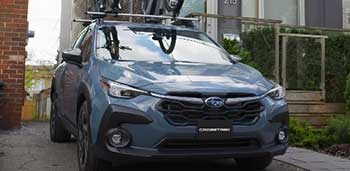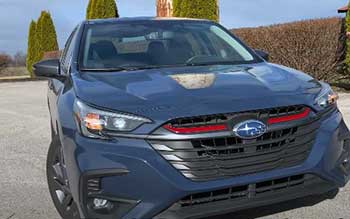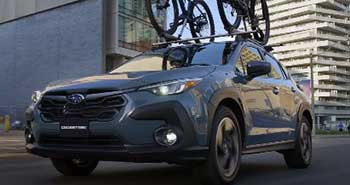
As a car enthusiast who’s spent countless hours behind the wheel, I’ve always been drawn to Subaru’s rugged charm and all-wheel-drive prowess.
Today, I’m exploring two of Subaru’s standout models: the Legacy, a midsize sedan with a refined edge, and the Crosstrek, a compact SUV built for adventure.
My goal is to break down their differences, weigh their strengths and weaknesses, and help you decide which fits your lifestyle.
Whether you’re a city commuter or an off-road explorer, this comparison will guide you through key features, performance, and practical considerations to make an informed choice.
Comparison Table
| Feature | Subaru Legacy (2024) | Subaru Crosstrek (2025) |
|---|---|---|
| Vehicle Type | Midsize Sedan | Compact SUV |
| Starting MSRP | $27,715 | $27,440 |
| Engine Options | 2.5L (182 hp), 2.4L Turbo (260 hp) | 2.0L (152 hp), 2.5L (182 hp) |
| Fuel Economy (MPG) | 27 city / 35 highway (2.5L) | 27 city / 34 highway (2.5L) |
| Ground Clearance | 5.9 inches | 8.7–9.3 inches |
| Cargo Space | 15.1 cu. ft. (trunk) | 54.7–55.3 cu. ft. (rear seats folded) |
| Towing Capacity | Not rated for towing | Up to 1,500 lbs (3,500 lbs Wilderness trim) |
| Interior Space | 105.5 cu. ft. passenger volume | 100.5 cu. ft. passenger volume |
| Infotainment | 11.6-inch touchscreen, Apple CarPlay/Android Auto | 11.6-inch touchscreen, Apple CarPlay/Android Auto |
| Safety Features | EyeSight Driver Assist, adaptive cruise control | EyeSight Driver Assist, X-MODE terrain settings |
| Ground Clearance | 5.9 inches | 8.7–9.3 inches |
My Experience With The Subaru Legacy
Growing up, I always admired the Subaru Legacy for its understated elegance. When I got the chance to drive a 2024 Legacy Limited, I was immediately struck by its smooth ride and upscale interior. The cabin felt like a step above the average midsize sedan, with soft-touch materials and a massive 11.6-inch touchscreen that made navigation a breeze.
On a weekend trip to the mountains, the Legacy’s 2.5-liter engine delivered steady power, and its fuel efficiency—averaging 30 MPG—kept my wallet happy. The Symmetrical All-Wheel Drive handled light snow with ease, though I noticed the low ground clearance made me cautious on uneven backroads.
However, the Legacy isn’t perfect. Its trunk, while decent at 15.1 cubic feet, felt limiting when I tried packing for a family camping trip. The sedan’s low stance also meant I had to be mindful when entering steep driveways.
For someone like me who occasionally craves off-road adventures, the Legacy felt more suited to highways and city streets. Still, its refined handling and comfortable seats made long commutes a pleasure, especially with the EyeSight system keeping me safe in traffic.
Pros Of The Subaru Legacy

- Fuel Efficiency: The Legacy’s 2.5-liter engine achieves 27 MPG city and 35 MPG highway, slightly better than the Crosstrek, making it a great choice for long-distance commuters. This efficiency saved me noticeable cash on a recent 400-mile road trip.
- Powerful Engine Options: The base 2.5-liter engine offers 182 horsepower, but the available 2.4-liter turbocharged engine pumps out 260 horsepower, giving the Legacy a punchy feel on highways. I felt the turbo’s pull during a quick merge onto the interstate.
- Premium Interior: The Legacy’s cabin feels high-end, with available leather upholstery and a spacious 105.5 cubic feet of passenger volume. I found it more comfortable for taller passengers compared to the Crosstrek.
- Advanced Technology: The 11.6-inch touchscreen with STARLINK multimedia, Apple CarPlay, and Android Auto is intuitive. I connected my phone seamlessly, and the system’s responsiveness was a highlight during daily drives.
- Safety Features: Standard EyeSight Driver Assist includes adaptive cruise control and pre-collision braking, which gave me peace of mind in stop-and-go traffic. The Legacy’s 5-star NHTSA safety rating is a testament to its reliability.
- Smooth Ride Quality: The Legacy’s suspension absorbs bumps well, making it ideal for city and highway driving. I barely felt road imperfections during a long commute.
Also read: My Thoughts on Acura ILX Vs. Honda Accord
Cons Of The Subaru Legacy
- Limited Cargo Space: The 15.1-cubic-foot trunk is smaller than the Crosstrek’s hatchback design, which I found restrictive when hauling camping gear or groceries for a big family event.
- Low Ground Clearance: At 5.9 inches, the Legacy struggles on uneven terrain or steep driveways. I scraped the undercarriage once on a gravel road, which was frustrating.
- Not Designed for Towing: Unlike the Crosstrek, the Legacy isn’t rated for towing, limiting its utility for those needing to haul trailers or equipment.
- Discontinuation Concerns: Subaru announced the Legacy’s discontinuation after 2025, which could affect resale value and parts availability down the line. This gave me pause when considering long-term ownership.
- Less Versatile Design: As a sedan, the Legacy lacks the crossover appeal of the Crosstrek, making it less suited for off-road or rugged adventures.
- Bland Exterior Styling: While functional, the Legacy’s design feels generic compared to the Crosstrek’s rugged aesthetic. I noticed it didn’t turn heads like other Subarus.
Maintenance Tips For The Subaru Legacy
- Regular Oil Changes: Change the oil every 6,000 miles or six months to keep the BOXER engine running smoothly. I stick to synthetic oil for better performance in cold weather.
- Tire Rotations: Rotate tires every 6,000–8,000 miles to ensure even wear, especially with the all-wheel-drive system. This helped me extend tire life significantly.
- Brake Inspections: Check brakes annually, as the Legacy’s AWD can put extra strain on them. I had my brakes serviced at 30,000 miles to avoid costly repairs.
- Air Filter Replacement: Replace the cabin and engine air filters every 15,000 miles to maintain air quality and engine efficiency. I noticed better HVAC performance after doing this.
- Coolant and Fluid Checks: Inspect coolant, transmission, and differential fluids every 30,000 miles. I caught a low coolant level early, preventing engine issues.
- Battery Maintenance: Test the battery every two years, especially in extreme climates. I replaced mine at three years to avoid being stranded in winter.
- Wiper Blade Replacement: Swap wiper blades yearly for clear visibility in rain or snow, a must for the Legacy’s safety features to work optimally.
My Experience With The Subaru Crosstrek
When I test-drove a 2025 Subaru Crosstrek Premium, I instantly felt its adventurous spirit. The higher seating position and 8.7 inches of ground clearance made navigating a bumpy forest trail feel effortless. I took it on a weekend getaway with my dogs, and the 54.7 cubic feet of cargo space (with rear seats folded) easily fit their crates and my gear. The 2.5-liter engine, with 182 horsepower, wasn’t lightning-fast but felt peppy enough for city driving. The X-MODE traction settings were a game-changer in mud, giving me confidence on slick surfaces.
On the flip side, the Crosstrek’s fuel economy (27 MPG city, 34 MPG highway) was slightly less impressive than the Legacy’s, and I noticed it on longer trips. The cabin, while practical, didn’t feel as luxurious as the Legacy’s, with more hard plastics. Taller friends also found the rear seats a bit cramped. Still, the Crosstrek’s versatility and off-road capability made it a fun companion for spontaneous adventures, especially with its rugged Wilderness trim option.
Pros Of The Subaru Crosstrek

- Off-Road Capability: With 8.7–9.3 inches of ground clearance and X-MODE, the Crosstrek tackles trails better than most compact SUVs. I breezed through a gravel path without worry.
- Spacious Cargo Area: Up to 55.3 cubic feet of cargo space with seats folded makes it ideal for gear-heavy trips. I packed camping equipment and dog supplies with room to spare.
- Towing Capacity: The Crosstrek tows up to 1,500 pounds (3,500 pounds in Wilderness trim), unlike the Legacy. This was handy for pulling a small trailer.
- Rugged Design: The Crosstrek’s bold styling and protective cladding give it an adventurous vibe. I got compliments at a trailhead for its outdoorsy look.
- Versatile Interior: The 60/40-split rear seats and hatchback design offer flexibility for passengers and cargo. I reconfigured the space easily for different trips.
- Safety and Tech: Like the Legacy, it has EyeSight Driver Assist and an 11.6-inch touchscreen. The adaptive cruise control saved me during a rainy commute.
Cons Of The Subaru Crosstrek
- Slightly Lower Fuel Economy: At 27 MPG city and 34 MPG highway, it’s less efficient than the Legacy, which I noticed on a 200-mile trip costing me a bit more at the pump.
- Less Powerful Base Engine: The 2.0-liter engine (152 horsepower) feels underpowered for highway passing. I had to plan overtakes carefully with the base model.
- Cramped Rear Seating: The 100.5 cubic feet of passenger volume is tighter than the Legacy, and my 6’4” friend felt squeezed in the back.
- Less Premium Interior: The Crosstrek’s cabin uses more hard plastics, feeling less luxurious than the Legacy. I missed the sedan’s upscale vibe.
- Slower Acceleration: Even the 2.5-liter engine isn’t as quick as the Legacy’s turbo option, which I felt when merging onto fast-moving highways.
- Higher Price for Features: Top trims like the Wilderness are pricier ($36,853), and you pay more for off-road upgrades compared to the Legacy’s base features.
Maintenance Tips For The Subaru Crosstrek
- Check AWD System: Inspect the all-wheel-drive system every 30,000 miles to ensure smooth operation, especially if you off-road frequently. I caught a minor issue early this way.
- Tire Maintenance: Rotate tires every 6,000 miles and check alignment, as off-road driving can wear them unevenly. I upgraded to all-terrain tires for better grip.
- Oil Changes: Like the Legacy, change oil every 6,000 miles. I use synthetic oil to protect the BOXER engine during rugged use.
- Clean Underbody: Rinse the undercarriage after off-roading to prevent rust, especially in snowy regions. I do this monthly in winter.
- X-MODE Calibration: Have X-MODE settings checked during annual service to maintain traction performance. This kept my Crosstrek trail-ready.
- Brake Checks: Inspect brakes every 15,000 miles, as off-road use can accelerate wear. I replaced brake pads early to avoid issues.
- Battery Care: Test the battery every two years, particularly if you use accessories like winches. I swapped mine at 36 months for reliability.
Comparison With Other Brands
- Subaru Legacy vs. Toyota Camry: The Camry offers similar fuel efficiency (28 MPG city/39 MPG highway) but lacks standard AWD. I found the Legacy’s AWD better for winter drives, though the Camry’s interior feels slightly more refined.
- Subaru Legacy vs. Honda Accord: The Accord’s base engine (192 hp) is peppier, but its FWD struggles in snow compared to the Legacy’s AWD. I preferred the Legacy for all-weather reliability.
- Subaru Crosstrek vs. Mazda CX-30: The CX-30 has sharper handling and a more upscale cabin, but its 6.1-inch ground clearance limits off-road ability. I chose the Crosstrek for trail adventures.
- Subaru Crosstrek vs. Toyota Corolla Cross: The Corolla Cross is cheaper ($26,250 starting) but has less cargo space (24.6 cu. ft.). I found the Crosstrek’s versatility superior for outdoor trips.
- Subaru Legacy vs. Nissan Altima: The Altima’s optional AWD is less robust than the Legacy’s standard system. I noticed the Legacy handled slick roads better during a rainstorm.
- Subaru Crosstrek vs. Hyundai Kona: The Kona’s turbo engine (195 hp) is quicker, but its 7.9-inch ground clearance is lower. I preferred the Crosstrek for off-road confidence.
- Subaru Legacy vs. Kia K5: The K5’s sporty design is eye-catching, but its AWD is optional and less refined. I found the Legacy’s ride smoother on long drives.
Also read: My Thoughts on Ford Edge Vs. Hyundai Tucson
Frequently Asked Questions (FAQ)
Its rugged design, standard AWD, and 8.7–9.3 inches of ground clearance make it a favorite for outdoor enthusiasts. The versatile cargo space and EyeSight safety features appeal to practical drivers.
The Legacy has limited cargo space (15.1 cu. ft.), low ground clearance (5.9 inches), and no towing capacity. Its discontinuation after 2025 may impact resale value.
Subaru ended Legacy production to focus on SUVs and crossovers, which are more popular. Market trends show sedans declining, so Subaru shifted to models like the Crosstrek and Outback.
The Legacy was discontinued after 2025 due to declining sedan sales and Subaru’s emphasis on SUVs. This reflects consumer demand for versatile, higher-clearance vehicles.
Conclusion: For The Subaru Legacy And Crosstrek
Choosing between the Subaru Legacy and Crosstrek depends on your driving needs. If you crave a smooth, fuel-efficient sedan for commutes and long highway trips, the Legacy’s refined interior and powerful engine options make it a strong pick.
Its upscale cabin and safety features kept me comfortable and secure. However, if you’re like me and love spontaneous adventures, the Crosstrek’s off-road capability, spacious cargo area, and rugged charm are hard to beat. You can’t go wrong with either, but your lifestyle—city slicker or trailblazer—will tip the scales. Test-drive both to find your perfect Subaru.

